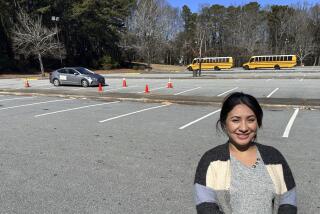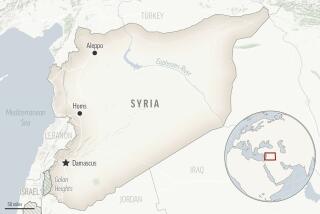Doctors travel a dangerous road to help ease the horrors of war-torn Aleppo, Syria
Along a stretch of two-lane highway outside Syria’s embattled city of Aleppo, government snipers, artillery and airstrikes can target everything that moves.
Drivers traverse it at high speed, slowing only to swerve around bomb craters.
Parts of the road are protected by earthen berms or heaps of old vehicles — the remains of cars, buses and trucks destroyed en route.
The stench of death emanates from decomposing bodies pinned in the overturned vehicles. The road is so dangerous that residents don’t dare to approach the cars to remove the dead for burial.

It may be one of the most dangerous roads on Earth — a stretch of two-lane highway outside the embattled Syrian city of Aleppo.
Aleppo, which has seen fierce fighting between the government forces of President Bashar Assad and rebels and has been under severe bombardment in recent days, was “hell,” said Dr. Samer Attar, an orthopedic surgeon from Chicago who recently volunteered to help in the city.
“I have no words to describe the fear and horror there,” Attar, who is Syrian American, said in an email. “It was hell…. I saw so many people die.”
Along with fellow volunteers Dr. Zaher Sahloul, a critical care specialist who also is Syrian American, and Dr. John Kahler, a pediatrician, both also from Chicago, Attar drove to Aleppo on June 29, entering via Turkey. They surveyed seven hospitals supported by the Syrian American Medical Society and other nongovernmental organizations, and they brought medical supplies and worked alongside other doctors in the Old City.
Sahloul and Kahler left Aleppo three days later, fearing the road would close, putting them, along with an estimated hundreds of thousands of others in rebel-held districts, under siege. Soon after, Castello Road, named for a restaurant and recreation center that no longer exist, came under new threat.
On Thursday, as it announced a “regime of calm” across the country, the Syrian government, with help from Russia and other forces, began a major offensive in and near Aleppo and advanced to within about 400 yards of the road, putting them in position to close it down.
I have no words to describe the fear and horror there. It was hell. ... I saw so many people die.
— Samer Attar, orthopedic surgeon from Chicago
Rebels regained some of the lost ground Saturday evening, but Syrian and Russian warplanes, firing as many as 100 missiles, retook it Sunday morning. At least 20 vehicles that attempted to traverse the road Sunday were hit by rockets, mortar fire or snipers. The wounded could not be rescued and the dead could not be buried because no one could get to the road, doctors at local hospitals said.
Attar had stayed an extra week and on Thursday worked at the main trauma hospital.
As helicopters and jets bombarded the rebel-held parts of the city, the hospital “would shake and the windows rattle from nearby blasts when we were operating,” Attar said. “We could not show fear. We had to be strong for other staff and for patients.”
The hospital is two stories underground. Wounded civilians overwhelmed the four operating rooms.
“Patient after patient nonstop was wheeled into the small emergency room,” Attar said. “I saw mutilated limbs, dismembered bodies, dead children, screaming patients. People literally bleed to death in front of you, and there is nothing you can do about it.”
The hospital has no morgue, so to make room for incoming patients, the bodies of the dead had to be wrapped in cloth and placed outside the hospital “amidst all the chaos,” he said.
The offensive began on the first day of Eid al-Fitr, ordinarily a time for celebration after a month of fasting for Muslims during Ramadan, and many of the wounded children arrived at hospital still in festive clothes.
The doctors’ trip provided a rare look at how health authorities cope in such conditions. Sahloul, a past president of the Syrian American Medical Society who had been to Syria 13 times before, said the medical facility had been targeted many times during the more than five years of civil war.
Foreign reporters rarely visit Aleppo, fearing kidnapping by Islamist groups but also because Turkey generally refuses passage.
Al Nusra Front, the Al Qaeda affiliate that has kidnapped reporters in the past, is a small player in Aleppo, but had a crucial role in Saturday’s pushback — carrying out three suicide attacks against government positions, rebel media reported.
Attar, Sahloul and Kahler, who are out of Syria, said their visit revealed not only the extreme gravity of the situation but also some unexpected glimpses of normality.
“You see pockets of life,” Sahloul said in a phone interview. There are schools, hospitals and markets and even fresh fruit is available, thanks to vendors risking their lives on Castello Road.
They did not see severe malnutrition in children. “That means food is still coming through,” Sahloul said.
In one neighborhood, “which looks like a tsunami has hit,” children scampered over piles of rubble to reach their homes, Sahloul said.
Kahler monitored about 150 children being examined in health clinics.
“They are pretty healthy kids,” he said in a phone interview, with mostly the same ailments as children everywhere, plus communicable diseases such as chickenpox and impetigo, a bacterial skin infection.
Another surprise: Parts of the rebel-held areas sustained little damage because they are near the front lines, where the government doesn’t drop barrel bombs for fear they might land on the territory it holds, Sahloul said.
Anticipating a siege, local authorities stocked food for three months and medical supplies for three to six months, Sahloul said.
Electricity is on only two hours a day, and the hospitals rely on diesel generators, powered by fuel arriving via Castello Road. There are not enough doctors or equipment.
Attar said the local medical staff members were “the most courageous and resilient group of people” he had met. “They don’t want sympathy or tears or condolences or apologies or concern or worries,” he said. “Some said they needed more body bags. They want these airstrikes to stop.”
But the airstrikes, the fighting and the deaths have continued. During the first three days of the government truce, 76 people were killed, 30 of them on Saturday, according to hospital staff. As warplanes attacked towns in the southern countryside of Aleppo and Castello Road and barrel-bombed the northern town of Hraytan, the government announced it was extending its “regime of calm” until July 12.
Sunday’s death toll could not be determined. On Monday, dozens more people were reported killed in airstrikes or fighting, Sahloul said.
When departing Aleppo, Sahloul and Kahler had set out just before dawn, driving without headlights. But as they advanced, oncoming cars were flashing their headlights — a warning to turn back because of warplanes above Castello Road.
“We heard bombs falling on either side,” Kahler said.
They got to an overpass and a truck in front of them stalled. “I thought now we are sitting ducks,” he said.
But the young driver maneuvered them out of it, and they continued.
“Those were the scariest 45 minutes of my life,” Kahler said.
Afterward, Sahloul asked him, with a tone “as earnestly as if he had a heart attack, ‘Did you pray?’ ”
Sahloul, who is Muslim, had said the prayer Muslims invoke on the verge of death: “We have no god but God, and Muhammad is his prophet.”
Kahler, who is Roman Catholic, said he invoked “any spirit that could help.”
Gutman is a special correspondent.
ALSO
South Sudan appears to be sliding back into war
Pentagon to increase U.S. troops in Iraq to help prepare assault on Mosul
More to Read
Start your day right
Sign up for Essential California for news, features and recommendations from the L.A. Times and beyond in your inbox six days a week.
You may occasionally receive promotional content from the Los Angeles Times.






